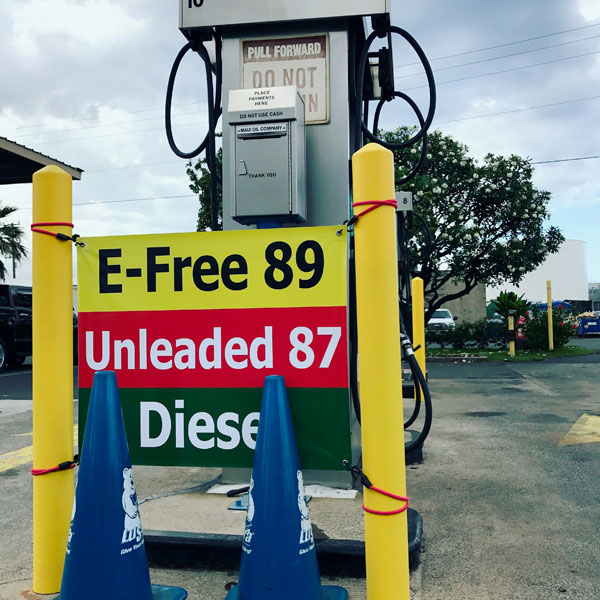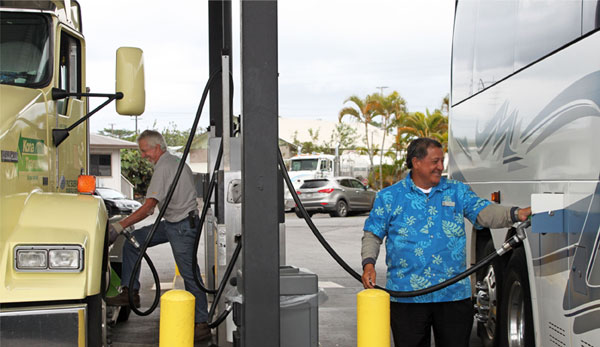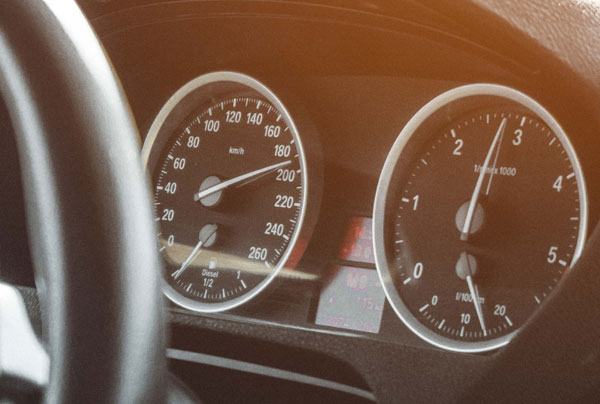
Photo by Julie B
Aloha Hawaiʻi! You might have driven by a gas station near you and seen signs advertising “Ethanol-Free Here!”, “Non-Ethanol Gas”, or similar messages and wondered what it meant, and more importantly, how would it affect your engine and gas mileage? After reading these facts about ethanol you’ll know what it’s made from, how ethanol and non-ethanol affects your car’s gas mileage, what types of engines it can be used in, and how it affects the environment. But first…

Photo by Todd Trapani
What is Ethanol?
Ethanol, also known as ethyl alcohol, grain alcohol, or even just alcohol, is a plant-based product. The type of ethanol that goes in your gasoline is typically produced from corn crops, sugar cane, or grasses, but it can potentially be made from many different types of plants. The leading producer of ethanol in the world is Brazil. Although it’s surprising to learn, alcohol (or ethanol) can be used to help fuel your vehicle, usually by being combined with gasoline.

Photo from Archive
How is it Used in Fuel?
So we’ve learned that ethanol can be used as a fuel, how precisely is it incorporated into the gasoline you pump at the station? At this point I should tell you that use of ethanol and labeling of it varies from state to state across the United States, so this will be a generalization, however it should still be a useful guideline to help you understand what type of fuel you’re putting into your car.
You can find ethanol in regular, midgrade, or supreme fuel types, and some stations even offer ethanol diesel. Most gasoline that’s available uses ten percent of ethanol in its mixture, and this variation is known as E10; The number that appears after the “E” tells you the percentage of ethanol by volume within the fuel. Any type of fuel that goes over ten percent ethanol by volume will have a label on it such as E15 or E85. This is because while all automakers have approved blends up to E10 in their vehicles, not all engines are equipped to run anything higher than that. However, a good rule of thumb is that if your car was manufactured after 2001, or it’s a specially equipped flex-fuel vehicle, you can use E15 fuel. BUT, E15 or higher is illegal to use in boats or other gasoline-powered equipment in the United States, because due to the water absorbing properties of ethanol, it can damage the components. To be sure of what grade of fuel is best for your vehicle, check the manual.

Photo by Lukass
Did You Say Ethanol Absorbs Water?
That’s right, but don’t worry! One of the properties of ethanol is that, when left to sit for a period of time, it can absorb water from humidity or other sources. This is why boat owners prefer ethanol-free gasoline, and why it’s also preferred for engines such as lawnmowers. But remember, the ethanol gas won’t start to go bad until about three months have passed. Plenty of time for most car owners to go through a tank of fuel, which is why ethanol fuel has become a widely adopted solution for vehicles in order to reduce greenhouse gas emissions.

Photo by Felix Mittermeier
Ethanol is Good for the Environment
Part of the Federal Renewable Fuel Standard, ethanol, a clean-burning fuel source, was introduced into gasoline in order to help reduce greenhouse gases. The environmental benefits of ethanol don’t stop there, either. It also dissolves in water, is non-toxic, and qualifies as a renewable energy source since it comes from crops. It also happens to be a chemical solvent, which is why you see alcohol used in cleaning so often. Flammability is also one of its properties, so be careful, just like you would with gasoline!

Photo by Hassan Ouajbir
How does it Affect my Mileage?
Ethanol contains roughly one third less energy than ethanol-free (also known as non-ethanol) gasoline does, which means you will get slightly fewer miles per gallon if you use E10 or E15. The fewer miles per gallon you get is small, but measurable. Vehicles will typically get 3-4% fewer miles per gallon out of their vehicle when running E10. For E15, the amount goes up to 4-5% fewer miles per gallon. For example, if you’re driving a vehicle that gets 32 miles per gallon, and you’re running E10, you would get between 0.96 to 1.28 miles less per gallon, taking you down to between 30.72 to 31.04 miles per gallon.

Photo from Archive
It All Boils Down to…
As the driver it’s your call if you’d prefer to run ethanol or non-ethanol fuel! There are a lot of options to consider from which type of engine you’re running, to your vehicle’s needs, and the environmental impact versus performance. Big Island Energy stations in Hilo and Kona are happy to provide both fuel types at a low cost, and our membership is free! I hope this helped explain the mysteries of ethanol and non-ethanol, and made it a little easier to decide which fuel to pick. Mahalo nui loa for reading, and aloha, a hui hou!
ShareJAN

About the Author:
Julie is Big Island Energy's Social Media and SEO Specialist.